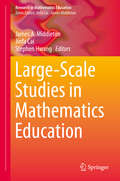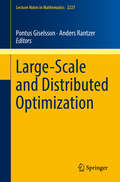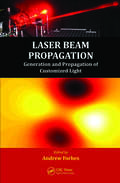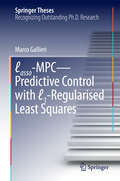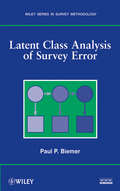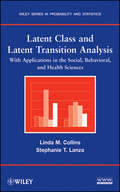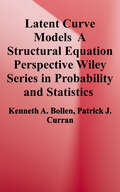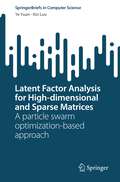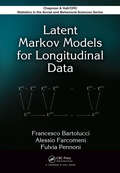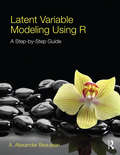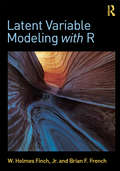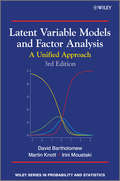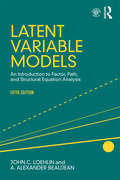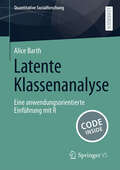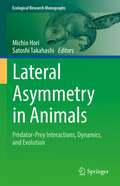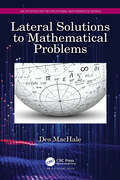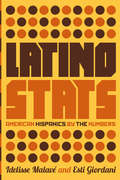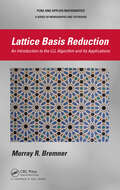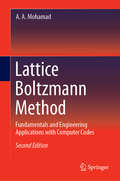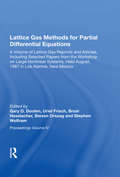- Table View
- List View
Large-Scale Studies in Mathematics Education
by Stephen Hwang James A. Middleton Jinfa CaiIn recent years, funding agencies like the Institute of Educational Sciences and the National Science Foundation have increasingly emphasized large-scale studies with experimental and quasi-experimental designs looking for 'objective truths' Educational researchers have recently begun to use large-scale studies to understand what really works, from developing interventions, to validation studies of the intervention, and then to efficacy studies and the final "scale-up" for large implementation of an intervention. Moreover, modeling student learning developmentally, taking into account cohort factors, issues of socioeconomics, local political context and the presence or absence of interventions requires the use of large data sets, wherein these variables can be sampled adequately and inferences made Inroads in quantitative methods have been made in the psychometric and sociometric literatures, but these methods are not yet common knowledge in the mathematics education community. In fact, currently there is no volume devoted to discussion of issues related to large-scale studies and to report findings from them This volume is unique as it directly discusses methodological issue in large-scale studies and reports empirical data from large-scale studies.
Large-Scale and Distributed Optimization (Lecture Notes in Mathematics #2227)
by Anders Rantzer Pontus GiselssonThis book presents tools and methods for large-scale and distributed optimization. Since many methods in "Big Data" fields rely on solving large-scale optimization problems, often in distributed fashion, this topic has over the last decade emerged to become very important. As well as specific coverage of this active research field, the book serves as a powerful source of information for practitioners as well as theoreticians.Large-Scale and Distributed Optimization is a unique combination of contributions from leading experts in the field, who were speakers at the LCCC Focus Period on Large-Scale and Distributed Optimization, held in Lund, 14th–16th June 2017. A source of information and innovative ideas for current and future research, this book will appeal to researchers, academics, and students who are interested in large-scale optimization.
Laser Beam Propagation: Generation and Propagation of Customized Light
by Andrew ForbesHow do laser beams propagate? Innovative discoveries involving laser beams and their propagation properties are at the heart of Laser Beam Propagation: Generation and Propagation of Customized Light. This book captures the essence of laser beam propagation. Divided into three parts, it explores the fundamentals of how laser beams propagate, and pro
Laser Interaction with Heterogeneous Biological Tissue: Mathematical Modeling (Biological and Medical Physics, Biomedical Engineering)
by Kirill Kulikov Tatiana KoshlanThis book introduces readers to the principles of laser interaction with biological cells and tissues with varying degrees of organization. In addition to considering the problems of biomedical cell diagnostics, and modeling the scattering of laser irradiation of blood cells for biological structures (dermis, epidermis, vascular plexus), it presents an analytic theory based on solving the wave equation for the electromagnetic field. It discusses a range of mathematical modeling topics, including optical characterization of biological tissue with large-scale and small-scale inhomogeneities in the layers; heating blood vessels using laser irradiation on the outer surface of the skin; and thermo-chemical denaturation of biological structures based on the example of human skin. In this second edition, a new electrodynamic model of the interaction of laser radiation with blood cells is presented for the structure of cells and the in vitro prediction of optical properties. The approach developed makes it possible to determine changes in cell size as well as modifications in their internal structures, such as transformation and polymorphism nucleus scattering, which is of interest for cytological studies. The new model is subsequently used to calculate the size distribution function of irregular-shape particles with a variety of forms and structures, which allows a cytological analysis of the observed deviations from normal cells.
Lasso-MPC - Predictive Control with ℓ1-Regularised Least Squares
by Marco GallieriThis thesis proposes a novel Model Predictive Control (MPC) strategy, which modifies the usual MPC cost function in order to achieve a desirable sparse actuation. It features an ℓ1-regularised least squares loss function, in which the control error variance competes with the sum of input channels magnitude (or slew rate) over the whole horizon length. While standard control techniques lead to continuous movements of all actuators, this approach enables a selected subset of actuators to be used, the others being brought into play in exceptional circumstances. The same approach can also be used to obtain asynchronous actuator interventions, so that control actions are only taken in response to large disturbances. This thesis presents a straightforward and systematic approach to achieving these practical properties, which are ignored by mainstream control theory.
Latent Class Analysis of Survey Error
by Paul P. BiemerCombining theoretical, methodological, and practical aspects, Latent Class Analysis of Survey Error successfully guides readers through the accurate interpretation of survey results for quality evaluation and improvement. This book is a comprehensive resource on the key statistical tools and techniques employed during the modeling and estimation of classification errors, featuring a special focus on both latent class analysis (LCA) techniques and models for categorical data from complex sample surveys.Drawing from his extensive experience in the field of survey methodology, the author examines early models for survey measurement error and identifies their similarities and differences as well as their strengths and weaknesses. Subsequent chapters treat topics related to modeling, estimating, and reducing errors in surveys, including:Measurement error modeling forcategorical dataThe Hui-Walter model and othermethods for two indicatorsThe EM algorithm and its role in latentclass model parameter estimationLatent class models for three ormore indicatorsTechniques for interpretation of modelparameter estimatesAdvanced topics in LCA, including sparse data, boundary values, unidentifiability, and local maximaSpecial considerations for analyzing datafrom clustered and unequal probability samples with nonresponseThe current state of LCA and MLCA (multilevel latent class analysis), and an insightful discussion on areas for further researchThroughout the book, more than 100 real-world examples describe the presented methods in detail, and readers are guided through the use of lEM software to replicate the presented analyses. Appendices supply a primer on categorical data analysis, and a related Web site houses the lEM software.Extensively class-tested to ensure an accessible presentation, Latent Class Analysis of Survey Error is an excellent book for courses on measurement error and survey methodology at the graduate level. The book also serves as a valuable reference for researchers and practitioners working in business, government, and the social sciences who develop, implement, or evaluate surveys.
Latent Class and Latent Transition Analysis
by Stephanie T. Lanza Linda M. CollinsA modern, comprehensive treatment of latent class and latent transition analysis for categorical dataOn a daily basis, researchers in the social, behavioral, and health sciences collect information and fit statistical models to the gathered empirical data with the goal of making significant advances in these fields. In many cases, it can be useful to identify latent, or unobserved, subgroups in a population, where individuals' subgroup membership is inferred from their responses on a set of observed variables. Latent Class and Latent Transition Analysis provides a comprehensive and unified introduction to this topic through one-of-a-kind, step-by-step presentations and coverage of theoretical, technical, and practical issues in categorical latent variable modeling for both cross-sectional and longitudinal data.The book begins with an introduction to latent class and latent transition analysis for categorical data. Subsequent chapters delve into more in-depth material, featuring:A complete treatment of longitudinal latent class modelsFocused coverage of the conceptual underpinnings of interpretation and evaluationof a latent class solutionUse of parameter restrictions and detection of identification problemsAdvanced topics such as multi-group analysis and the modeling and interpretation of interactions between covariatesThe authors present the topic in a style that is accessible yet rigorous. Each method is presented with both a theoretical background and the practical information that is useful for any data analyst. Empirical examples showcase the real-world applications of the discussed concepts and models, and each chapter concludes with a "Points to Remember" section that contains a brief summary of key ideas. All of the analyses in the book are performed using Proc LCA and Proc LTA, the authors' own software packages that can be run within the SAS® environment. A related Web site houses information on these freely available programs and the book's data sets, encouraging readers to reproduce the analyses and also try their own variations.Latent Class and Latent Transition Analysis is an excellent book for courses on categorical data analysis and latent variable models at the upper-undergraduate and graduate levels. It is also a valuable resource for researchers and practitioners in the social, behavioral, and health sciences who conduct latent class and latent transition analysis in their everyday work.
Latent Curve Models: A Structural Equation Perspective
by Kenneth A. Bollen Patrick J. CurranAn effective technique for data analysis in the social sciences The recent explosion in longitudinal data in the social sciences highlights the need for this timely publication. <p><p>Latent Curve Models: A Structural Equation Perspective provides an effective technique to analyze latent curve models (LCMs). This type of data features random intercepts and slopes that permit each case in a sample to have a different trajectory over time. Furthermore, researchers can include variables to predict the parameters governing these trajectories. <p><p>The authors synthesize a vast amount of research and findings and, at the same time, provide original results. The book analyzes LCMs from the perspective of structural equation models (SEMs) with latent variables. While the authors discuss simple regression-based procedures that are useful in the early stages of LCMs, most of the presentation uses SEMs as a driving tool. This cutting-edge work includes some of the authors' recent work on the autoregressive latent trajectory model, suggests new models for method factors in multiple indicators, discusses repeated latent variable models, and establishes the identification of a variety of LCMs.
Latent Factor Analysis for High-dimensional and Sparse Matrices: A particle swarm optimization-based approach (SpringerBriefs in Computer Science)
by Ye Yuan Xin LuoLatent factor analysis models are an effective type of machine learning model for addressing high-dimensional and sparse matrices, which are encountered in many big-data-related industrial applications. The performance of a latent factor analysis model relies heavily on appropriate hyper-parameters. However, most hyper-parameters are data-dependent, and using grid-search to tune these hyper-parameters is truly laborious and expensive in computational terms. Hence, how to achieve efficient hyper-parameter adaptation for latent factor analysis models has become a significant question.This is the first book to focus on how particle swarm optimization can be incorporated into latent factor analysis for efficient hyper-parameter adaptation, an approach that offers high scalability in real-world industrial applications. The book will help students, researchers and engineers fully understand the basic methodologies of hyper-parameter adaptation via particle swarm optimization in latent factor analysis models. Further, it will enable them to conduct extensive research and experiments on the real-world applications of the content discussed.
Latent Markov Models for Longitudinal Data (Chapman & Hall/CRC Statistics in the Social and Behavioral Sciences)
by Francesco Bartolucci Alessio Farcomeni Fulvia PennoniDrawing on the authors' extensive research in the analysis of categorical longitudinal data, this book focuses on the formulation of latent Markov models and the practical use of these models. It demonstrates how to use the models in three types of analysis, with numerous examples illustrating how latent Markov models are used in economics, education, sociology, and other fields. The R and MATLAB routines used for the examples are available on the authors' website.
Latent Variable Modeling Using R: A Step-by-Step Guide
by A. Alexander BeaujeanThis step-by-step guide is written for R and latent variable model (LVM) novices. Utilizing a path model approach and focusing on the lavaan package, this book is designed to help readers quickly understand LVMs and their analysis in R. The author reviews the reasoning behind the syntax selected and provides examples that demonstrate how to analyze data for a variety of LVMs.? Featuring examples applicable to psychology, education, business, and other social and health sciences, minimal text is devoted to theoretical underpinnings. The material is presented without?the use of matrix algebra. As a whole the book prepares readers to write about and interpret LVM results they obtain in R. Each chapter features background information, boldfaced key? terms defined in the glossary, detailed interpretations of R output, descriptions of how to write the analysis of results for publication, a summary, R based practice exercises (with solutions included in the back of the book), and references and related readings. Margin notes help readers better understand LVMs and write their own R syntax. Examples using data from published work across a variety of disciplines demonstrate how to use R syntax for analyzing and interpreting results. R functions, syntax, and the corresponding results appear in gray boxes to help readers quickly locate this material. A unique index helps readers quickly locate R?functions, packages, and datasets. The book and accompanying website at http://blogs.baylor.edu/rlatentvariable/ provides all of the data for the book’s examples and exercises as well as R syntax so readers can replicate the analyses. The book reviews how to enter the data into R, specify the LVMs, and obtain and interpret the estimated parameter values. The book opens with the fundamentals of using R including how to download the program, use functions, and enter and manipulate data. Chapters 2 and 3 introduce and then extend path models to include latent variables. Chapter 4 shows readers how to analyze a latent variable model with data from more than one group, while Chapter 5 shows how to analyze a latent variable model with data from more than one time period. Chapter 6 demonstrates the analysis of dichotomous variables, while Chapter 7 demonstrates how to analyze LVMs with missing data. Chapter 8 focuses on sample size determination using Monte Carlo methods, which can be used with a wide range of statistical models and account for missing data. The final chapter examines hierarchical LVMs, demonstrating both higher-order and bi-factor approaches. The book concludes with three Appendices: a review of common measures of model fit including their formulae and interpretation; syntax for other R latent variable models packages; and solutions for each chapter’s exercises. Intended as a supplementary text for graduate and/or advanced undergraduate courses on latent variable modeling, factor analysis, structural equation modeling, item response theory, measurement, or multivariate statistics taught in psychology, education, human development, business, economics, and social and health sciences, this book also appeals to researchers in these fields. Prerequisites include familiarity with basic statistical concepts, but knowledge of R is not assumed.
Latent Variable Modeling with R
by W. Holmes Finch Brian F. FrenchThis book demonstrates how to conduct latent variable modeling (LVM) in R by highlighting the features of each model, their specialized uses, examples, sample code and output, and an interpretation of the results. Each chapter features a detailed example including the analysis of the data using R, the relevant theory, the assumptions underlying the model, and other statistical details to help readers better understand the models and interpret the results. Every R command necessary for conducting the analyses is described along with the resulting output which provides readers with a template to follow when they apply the methods to their own data. The basic information pertinent to each model, the newest developments in these areas, and the relevant R code to use them are reviewed. Each chapter also features an introduction, summary, and suggested readings. A glossary of the text’s boldfaced key terms and key R commands serve as helpful resources. The book is accompanied by a website with exercises, an answer key, and the in-text example data sets. Latent Variable Modeling with R: -Provides some examples that use messy data providing a more realistic situation readers will encounter with their own data. -Reviews a wide range of LVMs including factor analysis, structural equation modeling, item response theory, and mixture models and advanced topics such as fitting nonlinear structural equation models, nonparametric item response theory models, and mixture regression models. -Demonstrates how data simulation can help researchers better understand statistical methods and assist in selecting the necessary sample size prior to collecting data. -www.routledge.com/9780415832458 provides exercises that apply the models along with annotated R output answer keys and the data that corresponds to the in-text examples so readers can replicate the results and check their work. The book opens with basic instructions in how to use R to read data, download functions, and conduct basic analyses. From there, each chapter is dedicated to a different latent variable model including exploratory and confirmatory factor analysis (CFA), structural equation modeling (SEM), multiple groups CFA/SEM, least squares estimation, growth curve models, mixture models, item response theory (both dichotomous and polytomous items), differential item functioning (DIF), and correspondance analysis. ?The book concludes with a discussion of how data simulation can be used to better understand the workings of a statistical method and assist researchers in deciding on the necessary sample size prior to collecting data.? A mixture of independently developed R code along with available libraries for simulating latent models in R are provided so readers can use these simulations to analyze data using the methods introduced in the previous chapters. Intended for use in graduate or advanced undergraduate courses in latent variable modeling, factor analysis, structural equation modeling, item response theory, measurement, or multivariate statistics taught in psychology, education, human development, and social and health sciences, researchers in these fields also appreciate this book’s practical approach. The book provides sufficient conceptual background information to serve as a standalone text.? Familiarity with basic statistical concepts is assumed but basic knowledge of R is not.
Latent Variable Models and Factor Analysis
by Irini Moustaki Martin Knott David J. BartholomewLatent Variable Models and Factor Analysis provides a comprehensive and unified approach to factor analysis and latent variable modeling from a statistical perspective. This book presents a general framework to enable the derivation of the commonly used models, along with updated numerical examples. Nature and interpretation of a latent variable is also introduced along with related techniques for investigating dependency.This book:Provides a unified approach showing how such apparently diverse methods as Latent Class Analysis and Factor Analysis are actually members of the same family.Presents new material on ordered manifest variables, MCMC methods, non-linear models as well as a new chapter on related techniques for investigating dependency.Includes new sections on structural equation models (SEM) and Markov Chain Monte Carlo methods for parameter estimation, along with new illustrative examples.Looks at recent developments on goodness-of-fit test statistics and on non-linear models and models with mixed latent variables, both categorical and continuous.No prior acquaintance with latent variable modelling is pre-supposed but a broad understanding of statistical theory will make it easier to see the approach in its proper perspective. Applied statisticians, psychometricians, medical statisticians, biostatisticians, economists and social science researchers will benefit from this book.
Latent Variable Models: An Introduction to Factor, Path, and Structural Equation Analysis, Fifth Edition
by A. Alexander Beaujean John C. LoehlinLatent Variable Models: An Introduction to Factor, Path, and Structural Equation Analysis introduces latent variable models by utilizing path diagrams to explain the relationships in the models. This approach helps less mathematically-inclined readers to grasp the underlying relations among path analysis, factor analysis, and structural equation modeling, and to set up and carry out such analyses. This revised and expanded fifth edition again contains key chapters on path analysis, structural equation models, and exploratory factor analysis. In addition, it contains new material on composite reliability, models with categorical data, the minimum average partial procedure, bi-factor models, and communicating about latent variable models. The informal writing style and the numerous illustrative examples make the book accessible to readers of varying backgrounds. Notes at the end of each chapter expand the discussion and provide additional technical detail and references. Moreover, most chapters contain an extended example in which the authors work through one of the chapter’s examples in detail to aid readers in conducting similar analyses with their own data. The book and accompanying website provide all of the data for the book’s examples as well as syntax from latent variable programs so readers can replicate the analyses. The book can be used with any of a variety of computer programs, but special attention is paid to LISREL and R. An important resource for advanced students and researchers in numerous disciplines in the behavioral sciences, education, business, and health sciences, Latent Variable Models is a practical and readable reference for those seeking to understand or conduct an analysis using latent variables.
Latente Klassenanalyse: Eine anwendungsorientierte Einführung mit R (Quantitative Sozialforschung)
by Alice BarthDas Buch bietet eine kompakte, anwendungsorientierte Einführung in die Technik der latenten Klassenanalyse. Grundlagen des Verfahrens sowie Voraussetzungen, praktische Anwendung und Ergebnisinterpretation werden verständlich erläutert. Die Analyse latenter Klassen ist ein statistisches Klassifikationsverfahren, bei dem mehrere kategoriale, manifeste Variablen zu vorher unbeobachteten Gruppen zugeordnet werden. So können z.B. aus einer Vielzahl von Variablen Typologien entwickelt werden. Für die Durchführung der Analysen wird die Open Source-Statistikumgebung R genutzt. Die verwendeten Syntaxbefehle sowie die Ausgabe der Ergebnisse werden erläutert, zusätzlich sind die kommentierte R-Syntax sowie Beispieldaten als elektronisches Zusatzmaterial im GitHub-Repositorium des Buches auf SpringerLink verfügbar. Die in den Beispielen verwendeten Daten haben keine Zugangsbeschränkung und können kostenfrei heruntergeladen werden, um die Analysen selbst nachzuvollziehen.
Lateral Asymmetry in Animals: Predator-Prey Interactions, Dynamics, and Evolution (Ecological Research Monographs)
by Satoshi Takahashi Michio HoriThis book presents the latest research findings on the laterality of fish and other animals. It describes all aspects of lateral asymmetry, including ecology, morphology, behaviour, dynamics of lefty and righty morphs, genetics and evolution, through field observations, experiments and modeling. Lateral asymmetry in scale-eating cichlids gives a simple and beautiful example of negative frequency-dependent selection and resulting oscillation of lefty and righty morph frequencies. Lateral dimorphism is found not only in scale-eaters but in all orders of fish, shrimps and cuttlefish. Lateral asymmetry interacts between species through "cross-predation." Contrary to fish, lateral asymmetry in snails acts as, in most cases, positive frequency-dependent selection and provides deep insights into speciation. Especially, snakes eating righty snails facilitate speciation of lefty snails.As a collaboration work of field ecologists and theoretical biologists, this book covers a variety of topics on lateral asymmetry, which are consistently related to predation. The topics include behavioral ecology, population dynamics, physiology, evolution, genetics, development, learning and neuroscience, statistics, with the subjects of fish, shrimp, prawn, and crayfish, crab, cuttlefish, and snake and snail. Chapters cover new research results such as cuttlefish laterality dynamics, interaction between laterality of snails and snakes, evolution of laterality genetic system, and statistical analysis of laterality oscillation. Readers will appreciate the simplicity and beauty of lateral asymmetry and its profound impact on ecology and evolution.
Lateral Solutions to Mathematical Problems (AK Peters/CRC Recreational Mathematics Series)
by Desmond MacHaleLateral Solutions to Mathematical Problems offers a fresh approach to mathematical problem solving via lateral thinking. Lateral thinking has long been used informally by good mathematics teachers and lecturers to spice up their material and interest their students in the more artistic aspects of mathematical problem solving. In this book, the author attempts to carry out this process formally, with reference to specific, non-technical problems that are easily understood and explained at an intermediate level.This book is appropriate for interested high school students, undergraduates and postgraduates, looking for relief from technical material and also looking for insight into the methodology of mathematics; for teachers and lecturers looking for a novel approach to course material; and anyone interested in both mathematics and lateral thinking.
Latino Stats
by Idelisse Malavé Esti GiordaniAt a time when politics is seemingly ruled by ideology and emotion and when immigration is one of the most contentious topics, it is more important than ever to cut through the rhetoric and highlight, in numbers, the reality of the broad spectrum of Latino life in the United States. Latinos are both the largest and fastest-growing racial/ethnic group in the country, even while many continue to fight for their status as Americans.Respected movement builder and former leader of the Tides Foundation Idelisse Malavé and her daughter, Celeste Giordani--a communications strategist for the Social Transformation Project--distills the profusion of data, identifying the most telling and engaging facts to assemble a portrait of contemporary Latino life with glimpses of the past and future. From politics and the economy to popular culture, the arts, and ideas about race, gender, and family, Latino Stats both catalogs the inequities that plague Latino communities and documents Latinos' growing power and influence on American life.An essential tool for advocates, educators, and policy makers, Latino Stats will be a go-to guidebook for anyone wanting to raise their awareness and increase their understanding of the complex state of our nation.
Lattice Coding for Signals and Networks
by Ram ZamirUnifying information theory and digital communication through the language of lattice codes, this book provides a detailed overview for students, researchers and industry practitioners. It covers classical work by leading researchers in the field of lattice codes and complementary work on dithered quantization and infinite constellations, and then introduces the more recent results on 'algebraic binning' for side-information problems, and linear/lattice codes for networks. It shows how high dimensional lattice codes can close the gap to the optimal information theoretic solution, including the characterisation of error exponents. The solutions presented are based on lattice codes, and are therefore close to practical implementations, with many advanced setups and techniques, such as shaping, entropy-coding, side-information and multi-terminal systems. Moreover, some of the network setups shown demonstrate how lattice codes are potentially more efficient than traditional random-coding solutions, for instance when generalising the framework to Gaussian networks.
Lattice Basis Reduction: An Introduction to the LLL Algorithm and Its Applications (Chapman & Hall Pure and Applied Mathematics)
by Murray R. BremnerFirst developed in the early 1980s by Lenstra, Lenstra, and Lovasz, the LLL algorithm was originally used to provide a polynomial-time algorithm for factoring polynomials with rational coefficients. It very quickly became an essential tool in integer linear programming problems and was later adapted for use in cryptanalysis. This book provides an i
Lattice Boltzmann Method
by A. A. MohamadLattice Boltzmann Method introduces the lattice Boltzmann method (LBM) for solving transport phenomena - flow, heat and mass transfer - in a systematic way. Providing explanatory computer codes throughout the book, the author guides readers through many practical examples, such as: flow in isothermal and non-isothermal lid driven cavities;flow over obstacles;forced flow through a heated channel;conjugate forced convection; andnatural convection.Diffusion and advection-diffusion equations are discussed with applications and examples, and complete computer codes accompany the coverage of single and multi-relaxation-time methods. Although the codes are written in FORTRAN, they can be easily translated to other languages, such as C++. The codes can also be extended with little effort to multi-phase and multi-physics, if the reader knows the physics of the problem. Readers with some experience of advanced mathematics and physics will find Lattice Boltzmann Method a useful and easy-to-follow text. It has been written for those who are interested in learning and applying the LBM to engineering and industrial problems and it can also serve as a textbook for advanced undergraduate or graduate students who are studying computational transport phenomena.
Lattice Boltzmann Method: Fundamentals and Engineering Applications with Computer Codes
by A. A. MohamadThis book introduces readers to the lattice Boltzmann method (LBM) for solving transport phenomena – flow, heat and mass transfer – in a systematic way. Providing explanatory computer codes throughout the book, the author guides readers through many practical examples, such as:• flow in isothermal and non-isothermal lid-driven cavities;• flow over obstacles;• forced flow through a heated channel;• conjugate forced convection; and• natural convection.Diffusion and advection–diffusion equations are discussed, together with applications and examples, and complete computer codes accompany the sections on single and multi-relaxation-time methods. The codes are written in MatLab. However, the codes are written in a way that can be easily converted to other languages, such as FORTRANm Python, Julia, etc. The codes can also be extended with little effort to multi-phase and multi-physics, provided the physics of the respective problem are known.The second edition of this book adds new chapters, and includes new theory and applications. It discusses a wealth of practical examples, and explains LBM in connection with various engineering topics, especially the transport of mass, momentum, energy and molecular species.This book offers a useful and easy-to-follow guide for readers with some prior experience with advanced mathematics and physics, and will be of interest to all researchers and other readers who wish to learn how to apply LBM to engineering and industrial problems. It can also be used as a textbook for advanced undergraduate or graduate courses on computational transport phenomena
Lattice Gas Methods For Partial Differential Equations
by Gary DoolenAlthough the idea of using discrete methods for modeling partial differential equations occurred very early, the actual statement that cellular automata techniques can approximate the solutions of hydrodynamic partial differential equations was first discovered by Frisch, Hasslacher, and Pomeau. Their description of the derivation, which assumes the validity of the Boltzmann equation, appeared in the Physical Review Letters in April 1986. It is the intent of this book to provide some overview of the directions that lattice gas research has taken from 1986 to early 1989.
